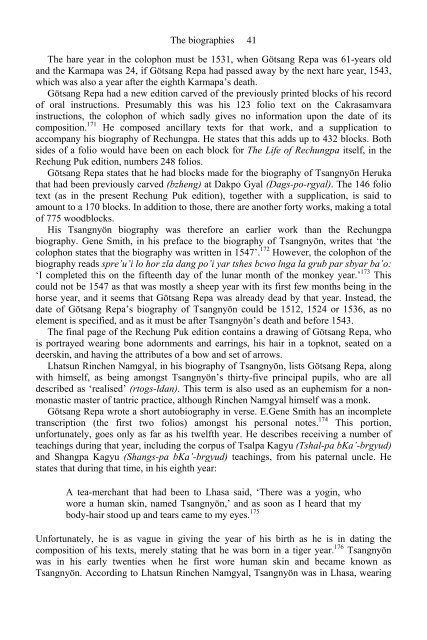The Biographies of Rechungpa: The Evolution of a Tibetan ...
The Biographies of Rechungpa: The Evolution of a Tibetan ...
The Biographies of Rechungpa: The Evolution of a Tibetan ...
You also want an ePaper? Increase the reach of your titles
YUMPU automatically turns print PDFs into web optimized ePapers that Google loves.
<strong>The</strong> biographies 41<br />
<strong>The</strong> hare year in the colophon must be 1531, when Götsang Repa was 61-years old<br />
and the Karmapa was 24, if Götsang Repa had passed away by the next hare year, 1543,<br />
which was also a year after the eighth Karmapa’s death.<br />
Götsang Repa had a new edition carved <strong>of</strong> the previously printed blocks <strong>of</strong> his record<br />
<strong>of</strong> oral instructions. Presumably this was his 123 folio text on the Cakrasamvara<br />
instructions, the colophon <strong>of</strong> which sadly gives no information upon the date <strong>of</strong> its<br />
composition. 171 He composed ancillary texts for that work, and a supplication to<br />
accompany his biography <strong>of</strong> <strong>Rechungpa</strong>. He states that this adds up to 432 blocks. Both<br />
sides <strong>of</strong> a folio would have been on each block for <strong>The</strong> Life <strong>of</strong> <strong>Rechungpa</strong> itself, in the<br />
Rechung Puk edition, numbers 248 folios.<br />
Götsang Repa states that he had blocks made for the biography <strong>of</strong> Tsangnyön Heruka<br />
that had been previously carved (bzheng) at Dakpo Gyal (Dags-po-rgyal). <strong>The</strong> 146 folio<br />
text (as in the present Rechung Puk edition), together with a supplication, is said to<br />
amount to a 170 blocks. In addition to those, there are another forty works, making a total<br />
<strong>of</strong> 775 woodblocks.<br />
His Tsangnyön biography was therefore an earlier work than the <strong>Rechungpa</strong><br />
biography. Gene Smith, in his preface to the biography <strong>of</strong> Tsangnyön, writes that ‘the<br />
colophon states that the biography was written in 1547’. 172 However, the colophon <strong>of</strong> the<br />
biography reads spre’u’i lo hor zla dang po’i yar tshes bcwo lnga la grub par sbyar ba’o:<br />
‘I completed this on the fifteenth day <strong>of</strong> the lunar month <strong>of</strong> the monkey year.’ 173 This<br />
could not be 1547 as that was mostly a sheep year with its first few months being in the<br />
horse year, and it seems that Götsang Repa was already dead by that year. Instead, the<br />
date <strong>of</strong> Götsang Repa’s biography <strong>of</strong> Tsangnyön could be 1512, 1524 or 1536, as no<br />
element is specified, and as it must be after Tsangnyön’s death and before 1543.<br />
<strong>The</strong> final page <strong>of</strong> the Rechung Puk edition contains a drawing <strong>of</strong> Götsang Repa, who<br />
is portrayed wearing bone adornments and earrings, his hair in a topknot, seated on a<br />
deerskin, and having the attributes <strong>of</strong> a bow and set <strong>of</strong> arrows.<br />
Lhatsun Rinchen Namgyal, in his biography <strong>of</strong> Tsangnyön, lists Götsang Repa, along<br />
with himself, as being amongst Tsangnyön’s thirty-five principal pupils, who are all<br />
described as ‘realised’ (rtogs-ldan). This term is also used as an euphemism for a nonmonastic<br />
master <strong>of</strong> tantric practice, although Rinchen Namgyal himself was a monk.<br />
Götsang Repa wrote a short autobiography in verse. E.Gene Smith has an incomplete<br />
transcription (the first two folios) amongst his personal notes. 174 This portion,<br />
unfortunately, goes only as far as his twelfth year. He describes receiving a number <strong>of</strong><br />
teachings during that year, including the corpus <strong>of</strong> Tsalpa Kagyu (Tshal-pa bKa’-brgyud)<br />
and Shangpa Kagyu (Shangs-pa bKa’-brgyud) teachings, from his paternal uncle. He<br />
states that during that time, in his eighth year:<br />
A tea-merchant that had been to Lhasa said, ‘<strong>The</strong>re was a yogin, who<br />
wore a human skin, named Tsangnyön,’ and as soon as I heard that my<br />
body-hair stood up and tears came to my eyes. 175<br />
Unfortunately, he is as vague in giving the year <strong>of</strong> his birth as he is in dating the<br />
composition <strong>of</strong> his texts, merely stating that he was born in a tiger year. 176 Tsangnyön<br />
was in his early twenties when he first wore human skin and became known as<br />
Tsangnyön. According to Lhatsun Rinchen Namgyal, Tsangnyön was in Lhasa, wearing











